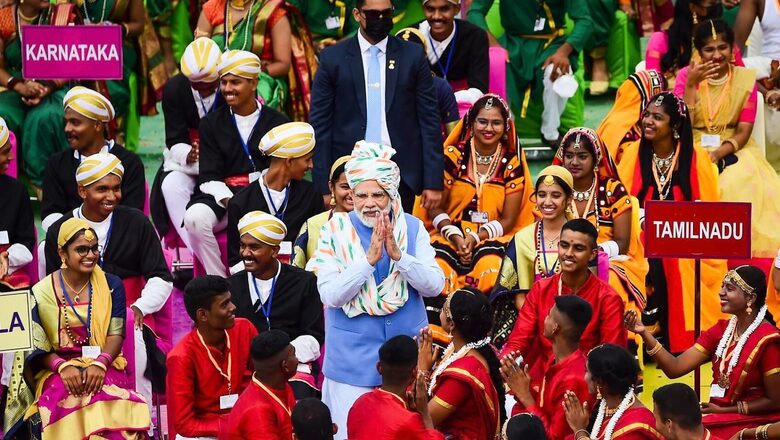
views
In 1997, Sunil Khilnani wrote The Idea of India. It examined where India had reached 50 years after Independence. The book quickly became required reading for those who wanted to understand a complex subcontinent.
In 1997, the Congress had been in power for 45 of India’s 50 post-Independence years. Jawaharlal Nehru, Indira Gandhi and Rajiv Gandhi were collectively prime ministers for more than 43 of those 50 years.
Not surprisingly, Khilnani’s idea of India was Nehruvian. In one passage he wrote: “The drafting of the Constitution rested in the hands of only about two dozen lawyers… Most people in India had no idea of what exactly they had been given. Like the British Empire it supplanted, India’s constitutional democracy was established in a fit of absentmindedness.”
That of course is nonsense. The British Empire was not established in a “fit of absentmindedness”. It is an enduring myth invented by British historians to airbrush the brutishness of the British Empire. The myth was swallowed by two generations of India’s post-Independence liberal elite.
The liberal elite, with colonially-rinsed minds, was neither liberal nor elite. It was intolerant of opposing points of view. Its members were mostly socio-economic climbers with newly washed money.
Khilnani says India’s constitutional democracy, like the British Empire, was also established in “a fit of absentmindedness”. That demeans the years of work Indian leaders like Babasaheb Ambedkar devoted to drafting a Constitution that has largely stood the test of time for 72 years.
Attempts to subvert it during the 1975-77 Emergency by Prime Minister Indira Gandhi were quickly reversed following her electoral defeat in the 1977 Lok Sabha election. A few subversions remain but the Constitution has risen above them.
Nehru deserves credit for laying the foundation for a newly independent, modern nation. India’s complexity of region, language, religion, caste and ethnicity is unique in the world. To lift a nation from destitution after 190 years of colonial exploitation called for extraordinary fortitude.
Nehru knew that British rule had left India impoverished. Life expectancy was 32 in 1947. The literacy rate was 12 per cent. Per capita income was among the lowest in the world. Nehru’s contribution towards establishing the IITs, IIMs and AIIMS, setting up organisations for space and nuclear research, and fusing a diverse country into a democracy remains unequalled.
Nehru, however, made mistakes on China and Pakistan and misjudged Hindu-Muslim relations. His policy of Muslim-first secularism, rather than genuine secularism that favours none and empowers everyone, set the stage for social divisions.
The misjudgement gave rise to a gradual build-up of Hindu resentment. Hindus are slow to anger. But suppressed resentment at being treated as second-class citizens in their own country, first by the Mughals, then by the British, and after independence by Muslim-first secular parties created a fertile environment for a Hindu-first party like the BJP.
Hindus are innately secular. Even today, despite centuries of Muslim and British rule and rising polarisation, more than half of India’s Hindus still do not vote for the BJP. Had Muslim-first secularism not been practised by the Congress and other parties, the BJP would not be in the position of strength it is today. Majoritarianism would have had little traction.
India is at an inflection point. The Covid-19 pandemic set the economy back by two years. The Russia-Ukraine war and tensions between China and Taiwan have disrupted trade. South Asia too is in turmoil: Sri Lanka, Pakistan and Afghanistan.
Ironically, unprecedented sanctions on Russia by the US-led West could benefit India geopolitically. With Western economies battling historically high inflation and slipping into recession, India’s pivotal role as a swing power in the Indo-Pacific has acquired new significance.
Both the US and China need to keep India onside. That is why Washington has not imposed CAATSA (Countering America’s Adversaries Through Sanctions Act) on New Delhi despite India buying five Russian S-400 air defence systems. Turkey, a US NATO ally which also bought the S-400, has in contrast been severely sanctioned under CAATSA.
China too is softening its stance against India. With Taiwan in its crosshairs, Beijing needs a face-saving exit from the Ladakh standoff with India. A straw in the wind was the recent visit to Delhi of China’s special envoy to Afghanistan, Yue Xiaoyong. It was agreed between the Indian and Chinese delegations that Afghan soil must not be used by terrorists to launch attacks on neighbouring countries. It was a rare example of India-China cooperation on terrorism.
Prime Minister Narendra Modi and Chinese President Xi Jinping could have their first face-to-face meeting during the Shanghai Cooperation Organisation (SCO) Summit in Samarkand, Uzbekistan on September 15-16. A thaw in the Ladakh standoff as winter approaches is clearly in both countries’ interests.
Modi’s second term as prime minister began with three polarising events: first, nullification of Section 370 on Jammu and Kashmir; second, the Supreme Court’s order on construction of the Ram Mandir in Ayodhya; and third, the promulgation of the Citizenship (Amendment) Act. Nearly half the prime ministerial term was subsequently taken up by the battle against Covid-19.
What does the future herald? The next decade will determine India’s rise as a global power. By 2025 it will overtake China as the world’s most populous nation. In 2027, India will surpass Germany as the world’s fourth largest economy. India’s consumer market is already the world’s second biggest. With over one billion mobile phone connections and the imminent rollout of 5G, India is in a technological sweet spot.
India’s social fabric needs to be repaired but not by adopting the methods of the old quasi-elite. A new idea of India is in the making. It is reflected in the fearless teenagers at the Chess Olympiad in Chennai, the sports heroes at the Commonwealth Games in Birmingham, and innovative startup entrepreneurs in tech hubs around the country. A new generation of can-do Indians is the new elite.
They are re-writing the idea of India: forward-looking, diverse and free of the burdens of the past.
The writer is editor, author and publisher. The views expressed in this article are those of the author and do not represent the stand of this publication personal.
Read the Latest News and Breaking News here



















Comments
0 comment